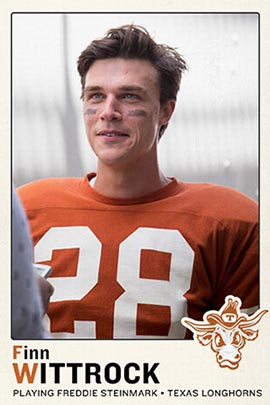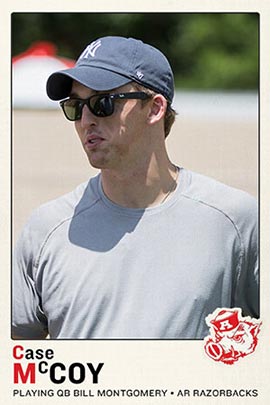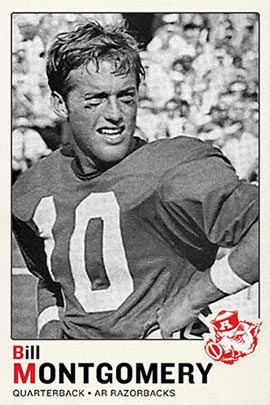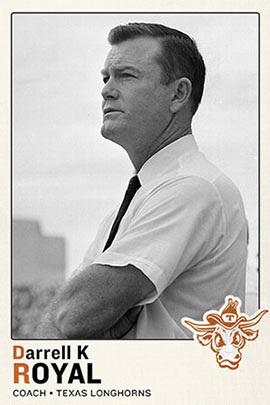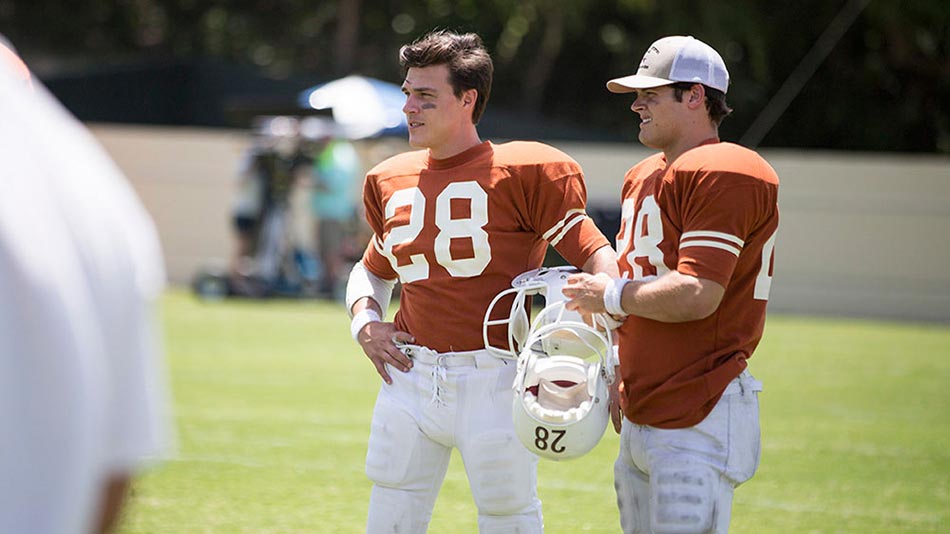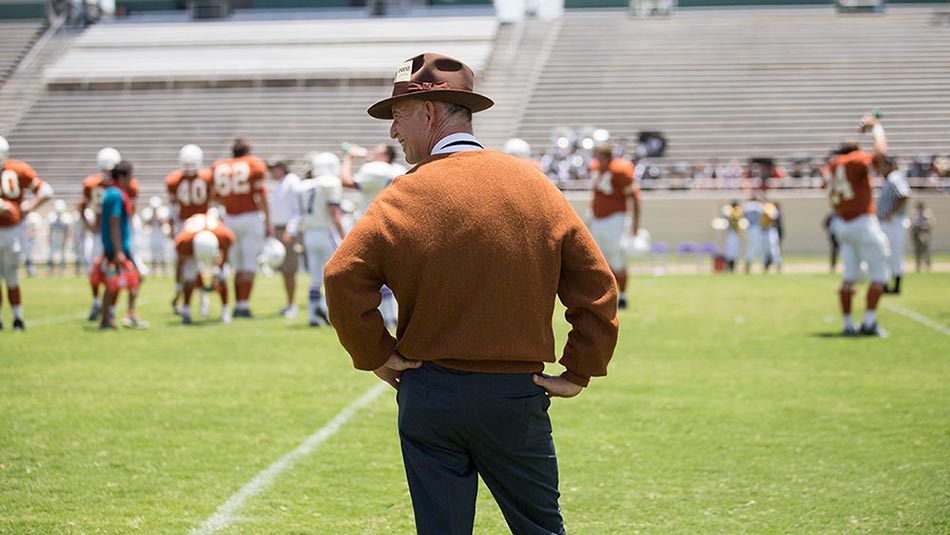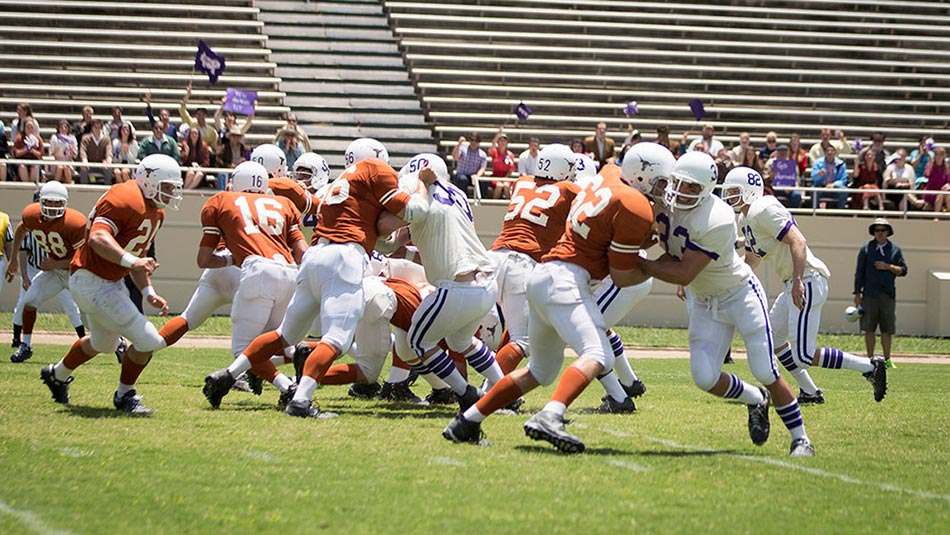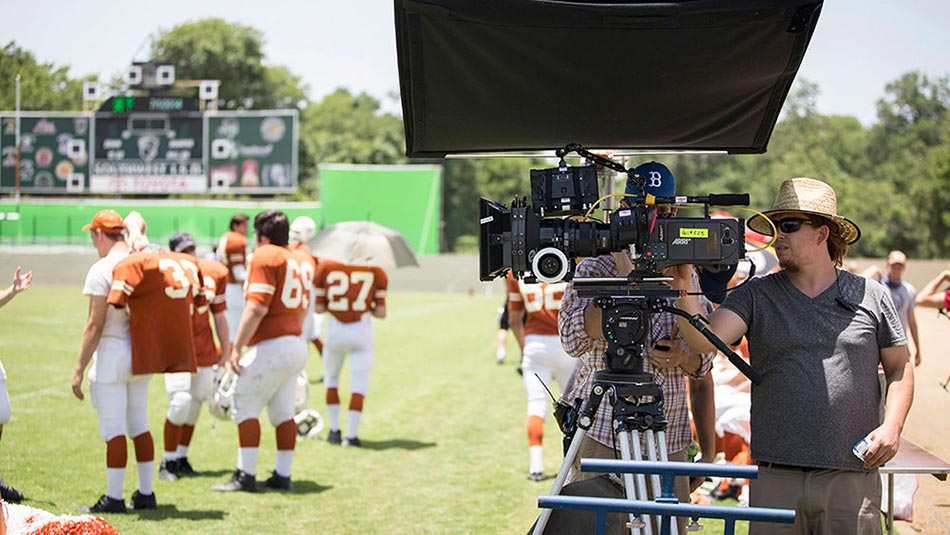Doo-doo-wah-shoobie-doobie...doo-doo-wah-shoobie-doobie...
Juston Street, son of Texas quarterback James and brother to Angels pitcher Huston, and the star of My All American, is scatting his way down the right sideline of Southwest Stadium (home of the Southwest High School Dragons!), wearing full pads and a megawatt grin. He is seemingly aloof to the hoopla surrounding him on set. It’s 95 degrees and rising, with no end to the shooting day in sight for director Angelo Pizzo and his crew of hundreds. Cardigan-clad coeds raise black umbrellas to blot out the San Antonio sun, and an older mustachioed man bicycles around the field’s dirt track, handing out tubes of sunscreen. And Street is singing “Poor Side of Town,” a 1966 No. 1 hit by Johnny Rivers, a song known well to malt shop patrons and drive-in moviegoers like his father, but properly obscure to anyone from Street’s generation. He’s not immune to the oppressive weather; this is how he gets into character. This was his father’s favorite song . Doo-doo-wah-shoobie-doobie …
Five minutes later, Street, BS ’08 takes a snap from under center, and pitches to a reversing Jordan Shipley, BS ’08, an All-American wide receiver for the Longhorns in the mid-to-late-aughts, who hurls the option pass to the right corner of the far endzone for a touchdown. Smokey the Cannon erupts, the crowd of extras goes wild, and they line up to shoot it again. Street and his co-stars are having fun beating up on the same teams his dad used to. When Street takes each snap, he’s echoing moments from 45 years earlier, when Texas’ actual quarterback was his father James. The play, perfectly executed against TCU during the 1969 season, is part of a montage of beatdowns that Texas doled out that year—SMU and Texas Tech’s massacres will be filmed later in the day—en route to a national championship. The elder Street passed away in September 2013 from a heart attack. The five Street boys grieved—their father was their hero—along with their mother Janie, BA ’78, Life Member. And then, a few months later, Juston’s phone buzzed. It was a text from his agent.
“Come home. Shave your beard, cut your hair,” the message read. “You’re auditioning to play your dad.”
As compelling as this is—the son becoming the father—this is not James’ story. It is Freddie Steinmark’s story, and Juston and James Street, ’70, Life Member, are just two supporting characters in the epic production of the film that is, as of press time, titled My All American.
The basis for the movie, which is slated to hit theaters this winter, is an inspiring true UT story that—inexplicably—has never been told on film before. It’s a sports story, but, as everyone knows, the best sports stories aren’t really about sports.

 A clapper marks the take on the set of My All American.
A clapper marks the take on the set of My All American.
It goes like this: An unrecruited, undersized walk-on becomes close with a coach who is known to be distant if not cold with most players. He then goes on to play in one of the most famous college football games of all time, with a sitting president in the audience, leaving the game early because his leg is about to snap under the weight of an enormous tumor. The team wins the national championship and his leg is removed six days later. He returns triumphantly weeks later in a show of solidarity toward his teammates, and tragically dies less than two years after that, becoming a symbol of perseverance to future generations of Longhorns. If the story of Freddie Steinmark, ’71, sounds saccharine, it’s because the narrative is well-worn. It’s a Douglas Sirk melodrama with slightly more shoulder pads and less Vaseline on the camera lens.
"And it has to appeal to people who care less about football, or UT football, or Texas—this is a universal story that has universal appeal."
Steinmark was a small Colorado boy, who teamed up with the hulking future Longhorn leader Bobby Mitchell to form an offensive tandem at Wheatridge High School, just outside of Denver. Mitchell, 50 pounds heavier than the diminutive Steinmark, looked like a football player. Freddie did not, though both players caught on at UT, with coach Darrell K Royal taking a leap of faith with some under-the-radar talent after a pair of middling four-loss seasons. Steinmark—all 150ish pounds of him—wound up starting every game for the Longhorns, rocketing up the depth chart using old-timey football euphemisms like “grit” and “scrappiness.” He picked off five passes as a starting safety in 1968 as the Longhorns won the Southwest Conference Championship and two in 1969, Steinmark’s junior season, in which Texas played one of the most fabled college football games in history, the Big Shootout against Arkansas. Texas, of course, won 15-14 in a game attended by President Richard Nixon, who presented UT with a plaque and proclaimed them national champions after the game. Steinmark, removed from the game with soreness in his leg, never played another down of football. Six days later, doctors at MD Anderson found a tumor the size of a softball and amputated his left leg. He showed up to the Cotton Bowl Classic on crutches—he refused a wheelchair—to watch his beloved teammates take down Notre Dame. Freddie’s bone sarcoma returned less than two years later, taking his life.
“In a way, it is sort of a love letter to UT and UT football,” Pizzo says. This is a man who knows a thing or two about metaphorical love letters. He wrote two of the most celebrated sports weepies of all time—Hoosiers and Rudy. “And it has to appeal to people who care less about football, or UT football, or Texas—this is a universal story that has universal appeal.”
This time Pizzo is the director as well, a first for him. And what he’s trying to do, whether with a wishbone option play, a barroom scene between players, or a tear-jerking moment is keep the story real. Pizzo believes Steinmark’s story doesn’t need much embellishment or Hollywood magic, and that’s what he told Bud Brigham, BS ’83, an oilman turned executive producer and main financier of the film, when he was lobbying to become the director.
“If you really want the tonal qualities or emotional qualities of Rudy or Hoosiers, then I’m your guy,” Pizzo says he told Brigham. “If you hand it to somebody else, you never know what you’re going to get.”
Pizzo learned about Steinmark while reading Horns, Hogs, and Nixon Coming, which contains a chapter dealing with the saga. “It’s kind of like Rudy,” he says. “You couldn’t make Rudy unless it’s true. You couldn’t make this movie unless it’s true.”
And true it is, to the last detail. From the remarkable tragedy to triumphant defensive stand, every last bit of ephemera is scrutinized, because Texas takes football seriously.
“We have players from the team on our set almost every single day, and it’s great because they are the ultimate ‘bullshit detectors,’” Pizzo says, grinning. “They will say, ‘We wouldn’t do this, that wouldn’t happen.”
Finn Wittrock, a former soap opera star, plays Steinmark in the film, and one of the most difficult scenes to shoot was the Notre Dame game, after Steinmark’s leg has been amputated. It’s a moment burned into the memory of everyone who was in the stands or watched the game on TV. Steinmark makes his triumphant return on crutches, hobbling over to his teammates. Wittrock says it was noticeably quiet that day on the set.
“It was tough,” he says. “That was one of the ones where I was like, ‘Well, we’re doing something right because all the old men are crying.’
The main BS detector on set is Billy Schott, BS ’83, and he’s been there every single day they shoot football scenes, serving as a technical advisor on the film. He’s primarily concerned with the most critical aspect of the film’s wardrobe: the uniforms. The facemasks, for example, are bulkier and more sturdy in the film than they were back then. It’s a detail for which Schott was scrutinized until everyone noticed how realistic the hitting was. And Schott should know what doesn’t look right—he was there. He was the ball boy for the 1969 team. His father—a diehard Longhorns fan who drove Schott to MD Anderson when Freddie learned of his fate—draped him in burnt orange from birth, and they used to meet the team out at Mueller Airport to send them off to New Orleans or welcome them home from Little Rock. Royal took a shine to the young Schott and called him up to the big leagues in 1962. Steinmark bonded with Schott, once even giving him the shirt off his back. They were like brothers, Schott says. Everyone was blindsided by Steinmark’s diagnosis, but for an out-of-his-league ball boy who just made friends with the team captain, it was earth-shattering.
“I thought that was something older people got. I’d always heard about, y’know, one of my grandmothers used to talk about ‘the cancer,’” Schott says. “And whenever this happened, I just didn’t understand how it could happen to someone so young and such a good person. You wouldn’t want to wish it on anybody, but somebody like Freddie, it’s unfathomable how to react to that.”
Today, as we sit in the Dragons’ home locker room, reliving the moments surrounding Steinmark’s diagnosis and amputation makes him cry. There’s a scene in the film where Steinmark puts his football cleat on before the Notre Dame game, and it’s filmed from Schott’s point of view, looking out from Freddie’s locker. Schott couldn’t watch that day.
“It was too powerful,” he says.
Schott’s voice gets quieter, and it is hard to hear him now over the sound of the extras chatting before it’s time to take the field. He looks upset.
As the equipment managers argued over putting out one shoe or two for Freddie’s return, Schott interrupted them. He had just seen Steinmark at MD Anderson, and the answer was obvious: two shoes for Freddie.
That was one of the [scenes] where I was like, 'Well, we're doing something right because all the old men are crying.'
“Freddie wanted people to know and feel that he was still whole,” Schott says. “He said his biggest concern was that people would look at him as being incomplete.”
Schott looks up at me, his eyes now pooling with tears, his face reddening. He apologizes.
“So he’s … always been whole to me.”
Schott made the Longhorn football team as a sophomore in 1972, and was immediately thrust into a starting role. Slight of build, like Steinmark, Schott was the team’s kicker when the University of Miami Hurricanes rolled into Austin for the season opener on Sept. 23. His friend Freddie had died suddenly on June 6, 1971—exactly 18 months to the day after his final game—and Texas was honoring him before the game, by dedicating the scoreboard at Memorial Stadium to Steinmark.
“People ask me what is the most memorable field goal I kicked at Texas, and I say, ‘Well, it’s the first one I kicked,’” Schott says. “Before the [Miami] game—after the ceremony, as if I wasn’t nervous enough—Mr. Steinmark [Freddie’s father Fred Steinmark] came up behind me, kind of gave me a hug, and said, ‘I hope you put the first points on Freddie’s scoreboard.’ So I thought, ‘Well, that would be cool, but what are the odds?’ Sure enough, we had a drive that bogged down and Coach Royal called for a field goal, so I go out to my first kick at Texas. 37-yarder, made it.”

 Every Longhorn player and coach touches the Steinmark plaque as they exit the tunnel onto the field.
Every Longhorn player and coach touches the Steinmark plaque as they exit the tunnel onto the field.
In addition to the eponymously named scoreboard, the Longhorns still honor Steinmark on a daily basis during football season. Outside the locker room, on the way down the tunnel to the field, players pass the Steinmark plaque. Each player touches the talisman before games. According to Luke Poehlmann, BS ’11, a former offensive tackle who plays 1969 All-American lineman Bob McKay, when he was at UT, it was a requirement to touch the plaque. No one really needed prodding to honor Freddie, but there were dire consequences if you forgot.
“Every player touched their horns [to the plaque],” Poehlmann says. He’s towering over me and giving off some much needed shade as we bake outside his tiny actor’s trailer. “There was nobody that walked past. I remember Mad Dog [former strength and conditioning coach Jeff Madden] would get so mad. I mean, you would be dog-cussed and killed if you didn’t touch the horns.”
“I can’t tell you what he means to us and what he meant to the foundation of Texas and football,” Shipley says. “The first thing you see as you’re about to go through the tunnel is Freddie Steinmark’s plaque, and so that’s the first story you hear when you come in as a recruit. Mack Brown was really big on tradition … and Freddie was a big part of that.”
Steinmark’s story has become such a dogmatic narrative to incoming freshman players, such an ingrained piece of history from the moment they step foot on campus as high school seniors, that showing him respect is a reflex.
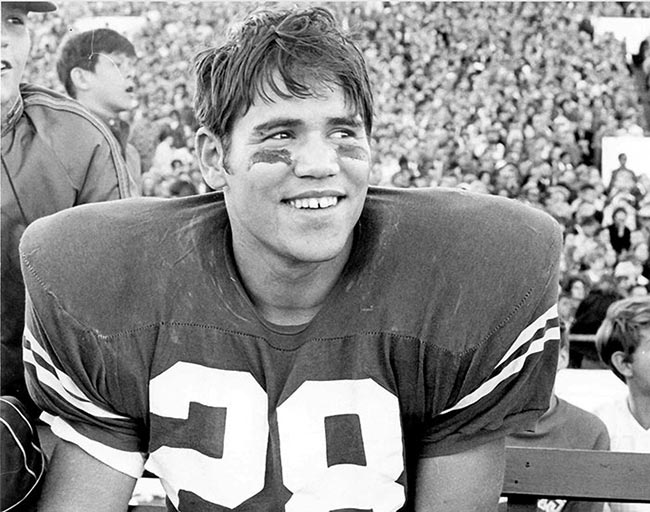
 Seeing Freddie Steinmark on the sidelines during his playing days meant one thing: The offense was on the field. Steinmark started every game during his sophomore and junior seasons.
Seeing Freddie Steinmark on the sidelines during his playing days meant one thing: The offense was on the field. Steinmark started every game during his sophomore and junior seasons.
“I would be walking a friend around campus and be showing them the field and out of habit would reach out my horn and touch that thing,” Poehlmann says smiling. “It was like second nature, it was like without even thinking I’d carry a conversation but my hand would go out to touch it.”
“That first day you come as a freshman,” former QB Case McCoy, BS ’13, says. “You learn the fight song and you learn the story of Freddie … that becomes part of you.”
While Shipley and Poehlmann reunited on the same side of the offense, McCoy also makes an appearance—as the enemy. McCoy, eager just to be involved in the telling of Steinmark’s story, gladly donned an Arkansas jersey and threw the backbreaking fourth quarter interception to actor Richard Kohnke, exactly as Razorbacks QB Bill Montgomery had thrown to Texas defensive back Tom Campbell, BBA ’72, sealing what was later dubbed the Game of the Century in favor of the Longhorns. “If it was OU or A&M or one of those teams, I couldn’t have done it.” McCoy says, squinting under a Yankees cap. “And I gave the game away to the right team.”
There are two Darrell K Royals. There’s the hard-nosed, throwback, national championship-winning coach, and there’s the man who still teared up at the mention of Steinmark’s name, even in the last few years of his life, when Alzheimer’s had ravaged his memory. Though the film will likely portray the latter version of Royal—it is Steinmark’s story, after all—it’s important to understand the former.
“I got to spend a couple hours with Coach Royal before he passed,” Pizzo says, of his early days of researching for the film. Pizzo rattled off the names of a few famous players. Royal nodded at a couple, though he looked puzzled at the mention of some of them. “I mentioned Freddie Steinmark, and something changed in his face. His eyes got watery, and I talked to [his wife] Edith about that afterwards, and she said that Freddie had a deep and profound effect on him, and that was even before he got sick. They recognized … something in each other.”
Aaron Eckhart had never heard Royal’s name when he signed on to play him. He showed up to Austin a month early to research, and to meet with Schott, DeLoss Dodds, and Royal’s widow Edith. He soaked in all he could about the man and his relationship with Steinmark. What was initially curiosity—as a football fan and with Pizzo attached, Eckhart was all-in from the beginning—became dedication to finding out who Royal was. Was he only interested in winning? Did he want to connect with his players? The answer is somewhere in between.
“You’ll see a picture of Darrell Royal smiling, and then you talk to his players, and they’ll tell you that he didn’t say four sentences to them in three or four years, and they were starting linebackers … it’s something I’ve struggled with the entire time,” Eckhart says, in between shooting scenes where he patrols the Texas sideline. “I can appreciate being the head of an organization that is so far-reaching, so powerful, you just don’t have the time. It’s not that he didn’t want to, maybe ... his head was full of other things.”
As it was then, and still is today, the head coach of a college football team really is like a CEO.
“And that’s what Mack Brown said, he goes, ‘You wouldn’t believe what I had to deal with on a daily basis,’” Eckhart says. “There’s gotta be a certain separation [between player and coach]. You always want to have them a little bit on the edge.”
That’s how James Street felt when coach Royal called him into his office one day: on the edge.
“I came out of there with my knees shaking,” Street told Texas Monthly in 1982, of the time Royal reprimanded the quarterback after a motorcycle trip he and another player took to Dallas. “We sure never went to him for fatherly advice.”
"In college football today and back then, it's like 'win at all costs'— but there's a human element, too, and Freddie is the human element."
“I don’t deny at all that we ran a tough program, especially back then,” Royal said in the same Texas Monthly piece. “I don’t think we ran it without feelings.”
Royal’s longtime friend and sportswriter Jim Dent, who wrote Courage Beyond the Game: The Freddie Steinmark Story, recognizes how, while he never yelled at players, Royal was “virile, driven, demanding.” Still, in the uncertain hours between learning that Steinmark might have cancer and when his leg was taken off, Royal wore a path into the floor at MD Anderson. “This just can’t be happening to a good kid like Freddie Steinmark,” he is known to have said. “This just can’t be happening.” Less than a month later, as the game clock ticked down to zero, ending their perfect season, Royal cried as he handed over the game ball to a crutched Steinmark.
“There are people [who said] he was hard, he was a taskmaster, and he wanted to win at all costs,” Eckhart says. “That’s another thing, too—in college football today and back then, it’s ‘win at all costs’—but there’s a human element, too, and Freddie is the human element.”
Steinmark was the one player to break through Royal’s hardened exterior, a sterling example that it wasn’t just about the X’s and O’s. There’s a famous image—famous in the Longhorn Universe, at least—from right after the Cotton Bowl. Royal has his face pressed against the side of Steinmark’s head, as if he’s whispering in the young man’s ear, and even though you can’t see his face, he’s undoubtedly smiling. Steinmark is also smiling, his arm resting on the coach’s shoulder, that same shoulder that Dent once described as containing "a chip as large as Bevo."
There’s an outpouring of love transpiring during filming. The players eat dinner every night together. Even after physically brutal and emotionally draining 12-hour days of filming, they can’t get enough of each other. They group text with an actor who was injured during a football scene. Street shows me his phone, and “I miss you bro”s and “Love you brother”s fill the screen as he scrolls. Always singing, he and Shipley harmonized on a song they wrote and recorded on a video message for their wounded friend. He was so touched that he cried as he watched it from his hospital bed.
First-time actors ask Wittrock if every set is like this one. It is not, he tells them: This one is special.
“It’s a dream come true,” Street says. “It’s like a walk between a dream and having him back. “But my main goal with the project,” he continues, “is to make Angelo’s vision and his story sing the way it was sung 40 years ago.”
That song brings him closer to a father to whom he already felt an indelible bond. He learned how his parents fell in love while researching his role. His mother had been seeing a wealthy kid when she met James, who parked his beat-up car down the block from her house when he picked her up so the first thing she saw wasn’t his caved-in roof. She didn’t even know he was the quarterback for a world-class football team, and even if she did, Juston says, it wouldn’t have made a lick of difference in the way she felt about him. There was something different about James Street in Janie’s eyes, in the same way there was something different that Royal recognized in Freddie Steinmark. But the connection was there, and that’s the shared experience in this love letter to Freddie, to Royal, to Texas. Everyone is trying to reconnect.
Take two. Shipley hurls another perfect spiral for a score, hitting his receiver in stride. Smokey booms again. Janie and James’ son sings a familiar refrain, one that’s been clanging around in his head all morning, as the offense leaves the field and Wittrock’s double, wearing Steinmark’s number 28, runs on with the defense. Juston has a moment to reconnect with his hero, and even if you don’t believe in the whole cosmic vibration, astral plane stuff, it still resonates.
Juston looks skyward.
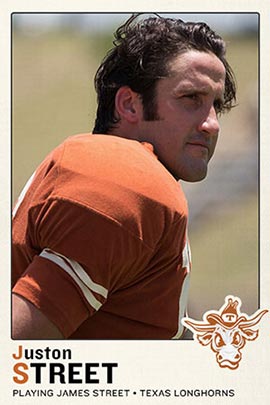
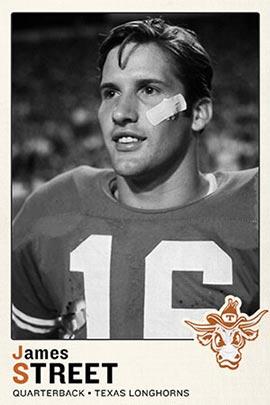

 A clapper marks the take on the set of My All American.
A clapper marks the take on the set of My All American.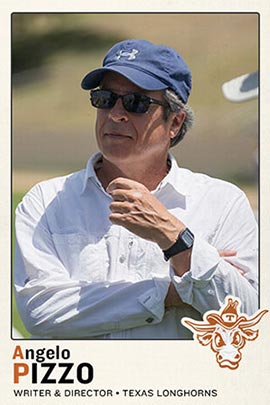
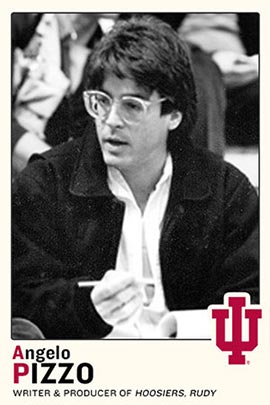

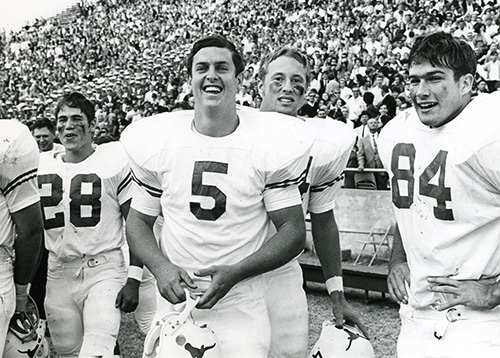







 Listen
Listen

